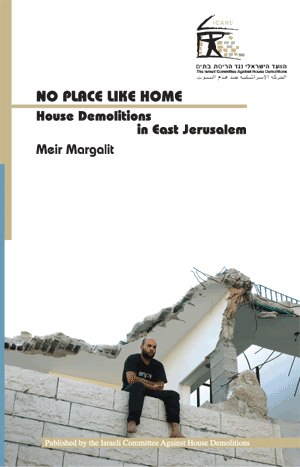No Place Like Home is the name of a report about house demolitions in East Jerusalem written Dr. Meir Margalit. It was published in March 2007 and is free from the site of the Israel Committee Against House Demolition.
House demolition is a favorite tactic used by the Israeli government in its ongoing ethnic cleansing of Palestinians from the West Bank and East Jerusalem. If anyone believes that Israel has given up its long term plans to take all of these regions and make them part of some greater religious/historical Israel entity, they should think again. This report discusses the East Jerusalem effort to reduce Palestinian presence in this city.
This is part of the introduction:
The years 2003-2005 were among the worst known to East Jerusalem for house demolitions; not only did the number of demolitions reach a peak of 350 buildings, but there was also an unprecedented severity in punitive enforcement measures. Residents of East Jerusalem found themselves: in a far more severe situation: enforcement measures were stepped up and there was an increase in red tape; those wishing to build legally found themselves frustrated at almost every turn. This report shows that from 2003 until 2005 the authorities took increasing steps to tighten the noose around the necks of East Jerusalem residents; faced with the incessant proliferation of bureaucratic, planning, legal, and economic hurdles, making it hopeless to obtain a building permit, they had to resort to unlicensed construction. Thus, fewer than 100 buildings were built under licence in East Jerusalem each year. Yet in the same period demand for housing in East Jerusalem rose steeply, due to the Wall construction around Jerusalem. As a result, thousands were forced inside Jerusalem’s municipal boundaries, enormously boosting illegal construction, which peaked in 2004 at 1,189 houses. Various red lines were crossed during that period. Shamelessly eager to demolish houses at all costs, municipal and Ministry of Interior inspectors resorted to underhand tactics of evasion or deception, disregarding court-issued decisions. The inspectors were prepared to trample the rule of law underfoot, so that the bulldozer did not, heaven forbid, return to base without having destroyed a home.
All this took place as Rabbi Uri Lupoliansky entered his first term of office as Mayor of Jerusalem, with Avraham Poraz and then Ophir Pines-Paz as Ministers of the Interior. The following survey begins with a chapter that presents 13-year data on demolitions, orders, fines and so forth, highlighting the escalation that took place during that period. The next part analyses the causes of illegal construction, ranging from planning difficulties such as lack of infrastructure and so forth, through legal difficulties such as furnishing proof of ownership, to economic difficulties such as the cost involved in fees and levies. The third section presents the motives underlying the Government’s demolition policy, emphasising the intention of limiting the living space of Palestinians of East Jerusalem in order to maintain the demographic balance between the two populations at a fixed ratio of 70-30%.
Focus will be given later in this work to the functioning of the bodies responsible for that policy on the professional and political levels: the construction supervision units of the Jerusalem Municipality and Ministry of the Interior, the local planning and building committee and the district planning and building committee. It must be stressed that these units are patently political bodies, representing the worldview of a right-wing government and municipality. The concluding chapter sets forth musings as to the significance of home demolition for a family, and what East Jerusalemites undergo from the time they are served the demolition order until the bulldozer arrives: the scars left on the souls of young children, and the effects of house demolition on the fabric of life in Jerusalem.
Interspersed throughout these chapters are a number of test cases. Clearly this research remains far from exhaustive; nevertheless, even in outline format, it is one of East Jerusalem’s most painful issues, which needs to be exposed to members of the public who hold dear the future of Jerusalem. Importantly, on March 13, 2007 the UN Committee on the Elimination of Racial Discrimination (CERD), delivered its CONSIDERATION OF REPORTS SUBMITTED BY STATES PARTIES UNDER ARTICLE 9 OF THE CONVENTION, to which ICAHD contributed. The Concluding Observations of the Committee (Israel) state: “35. The Committee notes with concern the application in the Occupied Palestinian Territories of different laws, policies and practices to Palestinians on the one hand, and to Israelis on the other hand. It is concerned, in particular, by information about unequal distribution of water resources to the detriment of Palestinians, about the disproportionate targeting of Palestinians in house demolitions and about the application of different criminal laws leading to prolonged detention and harsher punishments for Palestinians for the same offences. (articles 2, 3 and 5).”
The remainder of the small book can be downloaded free from the ICAHD site:
http://www.icahd.org/eng/images/uploaded_admin_content/NoPlaceLikeHome_withCover.pdf





